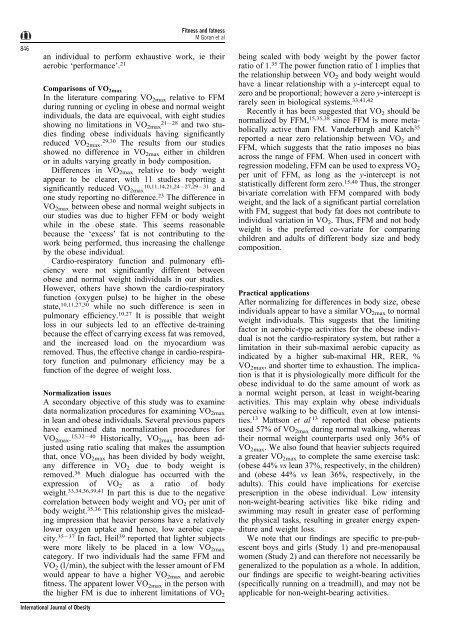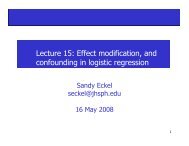Total body fat does not influence maximal aerobic capacity
Total body fat does not influence maximal aerobic capacity
Total body fat does not influence maximal aerobic capacity
You also want an ePaper? Increase the reach of your titles
YUMPU automatically turns print PDFs into web optimized ePapers that Google loves.
846<br />
an individual to perform exhaustive work, ie their<br />
<strong>aerobic</strong> `performance'. 21<br />
Comparisons of VO2max<br />
In the literature comparing VO2max relative to FFM<br />
during running or cycling in obese and normal weight<br />
individuals, the data are equivocal, with eight studies<br />
showing no limitations in VO2max 21 ± 28 and two studies<br />
®nding obese individuals having signi®cantly<br />
reduced VO2max. 29,30 The results from our studies<br />
showed no difference in VO2max either in children<br />
or in adults varying greatly in <strong>body</strong> composition.<br />
Differences in VO2max relative to <strong>body</strong> weight<br />
appear to be clearer, with 11 studies reporting a<br />
signi®cantly reduced VO 2max 10,11,14,21,24 ± 27,29 ± 31 and<br />
one study reporting no difference. 23 The difference in<br />
VO2max between obese and normal weight subjects in<br />
our studies was due to higher FFM or <strong>body</strong> weight<br />
while in the obese state. This seems reasonable<br />
because the `excess' <strong>fat</strong> is <strong>not</strong> contributing to the<br />
work being performed, thus increasing the challenge<br />
by the obese individual.<br />
Cardio-respiratory function and pulmonary ef®ciency<br />
were <strong>not</strong> signi®cantly different between<br />
obese and normal weight individuals in our studies.<br />
However, others have shown the cardio-respiratory<br />
function (oxygen pulse) to be higher in the obese<br />
state, 10,11,27,30 while no such difference is seen in<br />
pulmonary ef®ciency. 10,27 It is possible that weight<br />
loss in our subjects led to an effective de-training<br />
because the effect of carrying excess <strong>fat</strong> was removed,<br />
and the increased load on the myocardium was<br />
removed. Thus, the effective change in cardio-respiratory<br />
function and pulmonary ef®ciency may be a<br />
function of the degree of weight loss.<br />
Normalization issues<br />
A secondary objective of this study was to examine<br />
data normalization procedures for examining VO2max<br />
in lean and obese individuals. Several previous papers<br />
have examined data normalization procedures for<br />
VO 2max. 15,32 ± 40 Historically, VO 2max has been adjusted<br />
using ratio scaling that makes the assumption<br />
that, once VO2max has been divided by <strong>body</strong> weight,<br />
any difference in VO2 due to <strong>body</strong> weight is<br />
removed. 36 Much dialogue has occurred with the<br />
expression of VO2 as a ratio of <strong>body</strong><br />
weight. 33,34,36,39,41 In part this is due to the negative<br />
correlation between <strong>body</strong> weight and VO2 per unit of<br />
<strong>body</strong> weight. 35,36 This relationship gives the misleading<br />
impression that heavier persons have a relatively<br />
lower oxygen uptake and hence, low <strong>aerobic</strong> <strong>capacity</strong>.<br />
35 ± 37 In fact, Heil 39 reported that lighter subjects<br />
were more likely to be placed in a low VO2max<br />
category. If two individuals had the same FFM and<br />
VO2 (l=min), the subject with the lesser amount of FM<br />
would appear to have a higher VO2max and <strong>aerobic</strong><br />
®tness. The apparent lower VO 2max in the person with<br />
the higher FM is due to inherent limitations of VO 2<br />
International Journal of Obesity<br />
Fitness and <strong>fat</strong>ness<br />
M Goran et al<br />
being scaled with <strong>body</strong> weight by the power factor<br />
ratio of 1. 35 The power function ratio of 1 implies that<br />
the relationship between VO 2 and <strong>body</strong> weight would<br />
have a linear relationship with a y-intercept equal to<br />
zero and be proportional; however a zero y-intercept is<br />
rarely seen in biological systems. 33,41,42<br />
Recently it has been suggested that VO2 should be<br />
normalized by FFM, 15,35,38 since FFM is more metabolically<br />
active than FM. Vanderburgh and Katch 35<br />
reported a near zero relationship between VO2 and<br />
FFM, which suggests that the ratio imposes no bias<br />
across the range of FFM. When used in concert with<br />
regression modeling, FFM can be used to express VO2<br />
per unit of FFM, as long as the y-intercept is <strong>not</strong><br />
statistically different form zero. 15,40 Thus, the stronger<br />
bivariate correlation with FFM compared with <strong>body</strong><br />
weight, and the lack of a signi®cant partial correlation<br />
with FM, suggest that <strong>body</strong> <strong>fat</strong> <strong>does</strong> <strong>not</strong> contribute to<br />
individual variation in VO 2. Thus, FFM and <strong>not</strong> <strong>body</strong><br />
weight is the preferred co-variate for comparing<br />
children and adults of different <strong>body</strong> size and <strong>body</strong><br />
composition.<br />
Practical applications<br />
After normalizing for differences in <strong>body</strong> size, obese<br />
individuals appear to have a similar VO2max to normal<br />
weight individuals. This suggests that the limiting<br />
factor in <strong>aerobic</strong>-type activities for the obese individual<br />
is <strong>not</strong> the cardio-respiratory system, but rather a<br />
limitation in their sub-<strong>maximal</strong> <strong>aerobic</strong> <strong>capacity</strong> as<br />
indicated by a higher sub-<strong>maximal</strong> HR, RER, %<br />
VO 2max, and shorter time to exhaustion. The implication<br />
is that it is physiologically more dif®cult for the<br />
obese individual to do the same amount of work as<br />
a normal weight person, at least in weight-bearing<br />
activities. This may explain why obese individuals<br />
perceive walking to be dif®cult, even at low intensities.<br />
13 Mattson et al 13 reported that obese patients<br />
used 57% of VO2max during normal walking, whereas<br />
their normal weight counterparts used only 36% of<br />
VO 2max. We also found that heavier subjects required<br />
a greater VO2max to complete the same exercise task:<br />
(obese 44% vs lean 37%, respectively, in the children)<br />
and (obese 44% vs lean 36%, respectively, in the<br />
adults). This could have implications for exercise<br />
prescription in the obese individual. Low intensity<br />
non-weight-bearing activities like bike riding and<br />
swimming may result in greater ease of performing<br />
the physical tasks, resulting in greater energy expenditure<br />
and weight loss.<br />
We <strong>not</strong>e that our ®ndings are speci®c to pre-pubescent<br />
boys and girls (Study 1) and pre-menopausal<br />
women (Study 2) and can therefore <strong>not</strong> necessarily be<br />
generalized to the population as a whole. In addition,<br />
our ®ndings are speci®c to weight-bearing activities<br />
(speci®cally running on a treadmill), and may <strong>not</strong> be<br />
applicable for non-weight-bearing activities.




